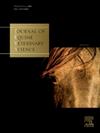Donkey sperm activating potential in heterologous ICSI
IF 1.3
3区 农林科学
Q2 VETERINARY SCIENCES
引用次数: 0
Abstract
There is a growing interest in the preservation and production of donkeys and mules, both species of significant importance in Argentina. The aim of this study was to evaluate the ability of cryopreserved donkey sperm to activate and induce pronuclear formation when injected into heterologous oocytes, as a potential predictor of future seminal capacity to produce embryos in vitro. Porcine cumulus-oocyte complexes (COCs) were obtained from ovaries of slaughtered gilts, selected, and then incubated, for 44 hours at 39°C, with 5% CO2 and 100% humidity, in 199 medium supplemented with 50 μg/ml gentamicin sulfate, 10% (v/v) porcine follicular fluid, 0.57 mM cysteine, 2 IU/ml equine chorionic gonadotropin, and 10 ng/ml epidermal growth factor. The matured COCs were denuded using serial passages through glass Pasteur pipettes. Donkey and equine sperm, cryopreserved with an egg yolk-free extender using a slow-freezing curve in an automatic freezer, were thawed in a water bath at 37°C for 1 minute and selected using Androcoll-ETM. A small aliquot was placed in a drop of 10% (v/v) polyvinylpyrrolidone in modified Whitten's (MW) injection medium. The oocytes were each placed in a drop of MW and intracytoplasmic sperm injection (ICSI) was performed. Porcine oocytes were injected with either equine sperm (control group) or donkey sperm (experimental group). As a control for the ICSI technique, and to assess parthenogenetic activation, mature oocytes were injected without depositing any sperm into the cytoplasm (Sham). Presumed zygotes were cultured for 16-18 hours in NCSU-23 medium at 39°C, with 5% CO2 and 100% humidity. They were then fixed for 15 minutes in 0.5% (v/v) glutaraldehyde in phosphate-buffered solution and stained for 10 minutes with Hoechst 33342 (5 µl/ml). Finally, they were classified as: 1) Activated: two pronuclei (2-PN) or one pronucleus with the presence of a decondensed sperm and 2) Non-activated: one pronucleus with the presence of a condensed sperm or no evidence of pronuclei. No significant difference was observed (p= 0.73) between activated porcine oocytes injected with donkey sperm: 66.67% (52/78) and those injected with equine sperm: 62.86% (44/70). Parthenogenetic development in the Sham group was 4.6% (3/65). Therefore, similar to equines, heterologous ICSI using donkey sperm could predict the future capacity of donkey semen for in vitro embryo production.
驴精子在异源ICSI中的激活电位
人们对驴和骡子的保护和生产越来越感兴趣,这两个物种在阿根廷都很重要。本研究的目的是评估低温保存的驴精子在注入异源卵母细胞时激活和诱导原核形成的能力,作为未来精子体外产生胚胎能力的潜在预测指标。选取已屠宰后备母猪卵巢中的猪卵母细胞卵母细胞复合物(COCs),在添加50 μg/ml硫酸庆大霉素、10% (v/v)猪卵泡液、0.57 mM半胱氨酸、2 IU/ml马绒毛膜促性腺激素、10 ng/ml表皮生长因子的199培养基中,在39℃、5% CO2、100%湿度条件下培养44 h。通过玻璃巴斯德移液管连续传代剥离成熟的COCs。驴和马的精子,用无蛋黄延长剂在自动冷冻机中用慢速冷冻曲线冷冻保存,在37°C的水浴中解冻1分钟,并使用Androcoll-ETM进行选择。在改良惠滕(MW)注射介质中,将一小部分等分液置于10% (v/v)的聚乙烯吡咯烷酮滴液中。卵母细胞分别置于一滴MW中,进行胞浆内单精子注射(ICSI)。分别用马精子(对照组)和驴精子(实验组)注射猪卵母细胞。作为ICSI技术的对照,并评估孤雌生殖激活,在不向细胞质中沉积任何精子的情况下注射成熟卵母细胞(Sham)。假设受精卵在NCSU-23培养基中培养16-18小时,温度为39°C, CO2为5%,湿度为100%。然后在0.5% (v/v)戊二醛磷酸盐缓冲溶液中固定15分钟,并用Hoechst 33342(5µl/ml)染色10分钟。最后,它们被分类为:1)激活:两个原核(2- pn)或一个原核,存在一个去浓缩的精子;2)非激活:一个原核,存在一个浓缩的精子或没有原核的证据。驴精子激活的猪卵母细胞为66.67%(52/78),马精子激活的猪卵母细胞为62.86%(44/70),两者差异无统计学意义(p= 0.73)。Sham组孤雌发育率为4.6%(3/65)。因此,与马类似,利用驴精子的异源ICSI可以预测驴精液体外胚胎生产的未来能力。
本文章由计算机程序翻译,如有差异,请以英文原文为准。
求助全文
约1分钟内获得全文
求助全文
来源期刊

Journal of Equine Veterinary Science
农林科学-兽医学
CiteScore
2.70
自引率
7.70%
发文量
249
审稿时长
77 days
期刊介绍:
Journal of Equine Veterinary Science (JEVS) is an international publication designed for the practicing equine veterinarian, equine researcher, and other equine health care specialist. Published monthly, each issue of JEVS includes original research, reviews, case reports, short communications, and clinical techniques from leaders in the equine veterinary field, covering such topics as laminitis, reproduction, infectious disease, parasitology, behavior, podology, internal medicine, surgery and nutrition.
 求助内容:
求助内容: 应助结果提醒方式:
应助结果提醒方式:


